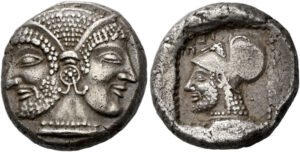The Mysterious Didrachm of Tenedos: A Coin with Two Faces and a Tragic Hero
If you’ve ever held an ancient Greek coin in your hand, you know there’s a kind of quiet magic to it. But few pieces are as mysterious—and as deeply rooted in myth—as the silver didrachm from the island of Tenedos, struck around 490–480 BC.
This coin isn’t just rare. It’s a window into a lost world of gods, heroes, and betrayal. Let’s take a closer look.
A Coin with Two Faces: Janiform Design
On the front (obverse) of the coin, we see something unusual: a pair of joined heads, one male and one female, both facing outward. The male figure has a beard, while the female is crowned with a stephane. Their shared earring is detailed with a floral rosette and elegant curved pendants.
Some scholars have interpreted this as a depiction of Zeus and Hera, the king and queen of the gods. The male figure’s beard, and in later versions his laurel wreath, suggest a divine identity—possibly Zeus. The female’s features and accessories point to Hera, though she’s more subtly rendered.
But here’s where it gets interesting: these faces aren’t clearly labeled. That ambiguity leaves room for other interpretations. Was this meant to show divine unity? Duality? Or was there another story behind the imagery?
Reverse Side: The Helmeted Man of Tenedos
On the back (reverse), the coin gets even more intriguing.
Instead of the typical double axe symbol used on many coins from Tenedos, this early version features the head of a bearded man in a Corinthian helmet, facing left. He’s surrounded by a square border, and beside him appears the name of the city, “TEN-E”, written in retrograde.
Who is this warrior?
The most compelling answer is Tenes, the legendary founder and hero of Tenedos. His story is one of pain, exile, and unshakable pride.
Who Was Tenes? The Tragic King of Tenedos
According to ancient myth, Tenes was the son of King Cygnus of Colonae and Proclia, a woman tied to the royal house of Troy. After Proclia died, Cygnus remarried—his new wife, Philonome, turned out to be the archetypal evil stepmother.
She falsely accused Tenes of attacking her. Cygnus believed her and condemned Tenes and his sister Hemithea to death. The two were locked inside a chest and thrown into the sea.
But instead of dying, they survived. The sea carried them to an island called Leucophrye, where they were rescued. The islanders took Tenes in and made him king, and the island was eventually renamed Tenedos in his honor.
A Family Cut Off
Later, King Cygnus discovered the truth. In horror, he punished Philonome and set sail for Tenedos to ask his children for forgiveness.
But Tenes would have none of it.
As Cygnus’s ship approached the island, Tenes reportedly took an axe and cut the moorings, refusing to allow his father to land. The symbolic act was clear: their bond was broken for good.
Death at the Hands of Achilles
Tenes’s life ended in tragedy. During the Trojan War, the great Greek warrior Achilles tried to seduce Hemithea. Tenes intervened to protect his sister.
Despite being warned by his mother Thetis not to harm Tenes—because doing so would anger Apollo—Achilles ignored the warning and killed him. That single act would later cost Achilles his own life in the war.
Tenes was remembered not just as a king, but as a symbol of justice and strength. His memory lived on in temples and coinage alike.
A Work of Art—and a Rarity
This particular didrachm is more than just myth wrapped in silver. It’s a masterpiece of early Greek engraving, with balanced composition and stunning detail for its time. The janiform heads are beautifully rendered, and the reverse portrait of Tenes stands out for its clarity and character.
Even among collectors, this coin is considered extremely rare. Only a handful of examples are known, and this variety—featuring the helmeted Tenes rather than the double axe—is likely unique. It was sold in important auctions like Nomos I (2009) and Triton XV (2012), highlighting its importance in the numismatic world.
Final Thoughts: A Coin with a Voice
Coins like this are more than currency. They’re a form of storytelling—tiny sculptures that speak across time. The didrachm of Tenedos tells us about identity, mythology, and a community that honored its roots in myth.
Whether it shows Zeus and Hera or simply the idea of duality, and whether the reverse celebrates Tenes as a godlike king or a mortal hero wronged by his own father, the message is clear: this is a coin with something to say.
And thousands of years later, we’re still listening.
🧭 Explore More
Visit NumisDon.com for more legendary coin stories, guides, and rare examples from the ancient world.

